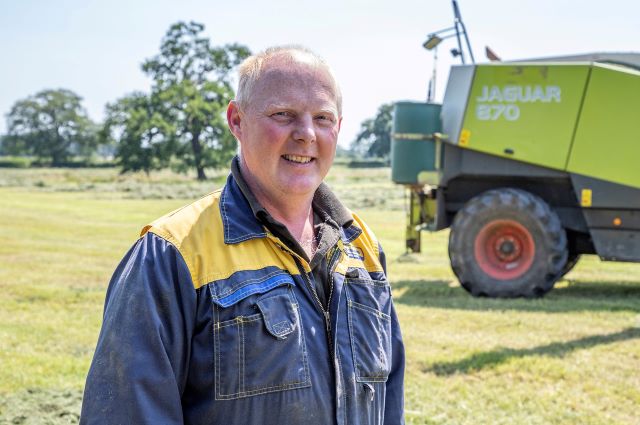Ian Richardson is acutely aware of the benefit of high-quality silage on milk production. His 500-cow herd has been delivering an extra two to three litres this year, which he says is directly a result of high-quality first cut silage.
|
Ian Richardson’s 500-cow herd has been delivering an extra two to three litres of milk this year from high-quality, first cut silage. |
“My cows have never milked as well on first cut silage, as they have this year,” explains Ian Richardson of Church Farm, Warmingham, Cheshire. “We aim for 28 per cent dry matter silage, and having switched to making a cut every five weeks, we’ve increased forage quality to a point where it means more milk in the tank.”
Taking more frequent cuts has required a rethink on silage-making, and the farm has recently geared up with kit, to allow it to take control of when and how it makes its silage.
An 18-year old self-propelled forager with a modest 480hp gives the fire-power needed, along with a four-rotor rake to create a generous swath, and increase productivity.
“2020 was our first season on our own, running a self-propelled forager,” he says. “We watch the forecast and try to get our timings right. But we’ve also added a four-rotor Vicon Andex 13m rake this year - we had one on demo, and realised the time it saved us, was phenomenal.”
He points out that nearly every forage contractor in the area operates a four-rotor rake, adding that the reasons for doing so, are clear.
“It’s all about getting the job done efficiently. You can’t guarantee settled weather periods, and we might only get a two-day weather window – so if I can get mine made in two days, it’s not a problem.”
The increase in efficiency has come solely from swapping to a four-rotor rake, and putting four rows into one.
“That bigger row has made a world of difference to our output,” he adds. “We had previously been putting three rows into one, but the rake operator was previously going like hell to keep in front of the forager.”
“With a four-rotor rake, we can operate at a much slower speed because we’re covering the ground much more easily, and making better use of our equipment.”
“So now the forager is working harder and not racing around, trailers aren’t racing around and we can also manage with three trailers instead of five,” he adds. “The forager is no longer waiting for trailers – we’re just so much more productive, and carrying much more grass back to the clamp with every load. I never thought this improvement could be down to a rake.”
|
Four-rotor Vicon Andex 1304 Pro has increased efficiency and productivity for the farm’s self-propelled forage harvester. |
Mr Richardson adds that the rake’s electric rotor height control – which can be controlled on-the-move from the cab - also provides a boost to forage quality.
“We’ve got control over not raking in any soil, and having the machine set right, so we can manage what we do,” he says. “It gives us confidence to start mowing from the first week in May, to get the grass at its highest quality. And then take subsequent cuts every five weeks.”
“That high quality forage is really important, because silage is my main driver for profit,” says Ian. “So if I don’t get good silage, I don’t get a good profit.”
